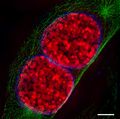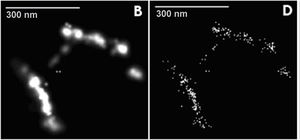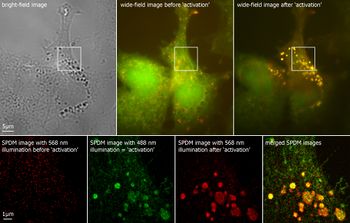المجهرية فائقة الدقة
المجهرية فائقة الدقة Super-resolution microscopy، هي شكل من المجهرية الضوئية. بسبب حيود الضوء، دقة المجهر الضوئي التقليدي تكون محدودة حسبما أعلن إرنست أبه عام 1873.[1] المقاربة الجيدة للدقة التي يمكن الحصول عليها هي العرض الكامل عند أقصى المنتصف (FWHM) في point spread function، ودقة widefield microscope with high numerical aperture and visible light usually reaches a resolution of ~250 nm.
Super-resolution techniques allow the capture of images with a higher resolution than the diffraction limit. They fall into two broad categories, "true" super-resolution techniques, which capture information contained in evanescent waves, and "functional" super-resolution techniques, which use clever experimental techniques and known limitations on the matter being imaged to reconstruct a super-resolution image.[2]
True subwavelength imaging techniques include those that utilize the Pendry Superlens and near field scanning optical microscopy, the 4Pi Microscope and structured illumination microscopy technologies like SIM and SMI. However, the majority of techniques of importance in biological imaging fall into the functional category.
There are two major groups of methods for functional super-resolution microscopy:
- Deterministic super-resolution: The most commonly used emitters in biological microscopy, fluorophores, show a nonlinear response to excitation, and this nonlinear response can be exploited to enhance resolution. These methods include STED, GSD, RESOLFT and SSIM.
- Stochastic super-resolution: The chemical complexity of many molecular light sources gives them a complex temporal behaviour, which can be used to make several close-by fluorophores emit light at separate times and thereby become resolvable in time. These methods include SOFI and all single-molecule localization methods (SMLM) such as SPDM, SPDMphymod, PALM, FPALM, STORM and dSTORM.
في 8 أكتوبر 2014، مُنحت جائزة نوبل في الكيمياء لإريك بتزيگ، وليام مورنر وشتفان هل عن "تطوير المجهر الفلوري فائق الدقة،" الذي يذهب "بالمجهر الضوئي إلى البعد النانوي".[3][4]
. . . . . . . . . . . . . . . . . . . . . . . . . . . . . . . . . . . . . . . . . . . . . . . . . . . . . . . . . . . . . . . . . . . . . . . . . . . . . . . . . . . . . . . . . . . . . . . . . . . . . . . . . . . . . . . . . . . . . . . . . . . . . . . . . . . . . . . . . . . . . . . . . . . . . . . . . . . . . . . . . . . . . . . .
التاريخ
التقنيات فائقة الدقة الحقيقية

- Images of cell nuclei and mitotic stages recorded with 3D-SIM Microscopy.
Cell nucleus in prophase from various angles
mouse cell in telophase
التقنيات الوظيفية القطعية
التقنيات الوظيفية الستوكاستيكية
دمج التقنيات
انظر أيضاً
المصادر
- ^ Abbe, E. (1873). "Beitrage zur Theorie des Mikroskops und der mikroskopischen Wahrmehmung". Archiv für Mikroskopische Anatomie. 9: 413–420. doi:10.1007/BF02956173. (بالألمانية)
- ^ Neice, A. (2010). "Methods and Limitations of Subwavelength Imaging". Advances in Imaging and Electron Physics. Advances in Imaging and Electron Physics. 163: 117. doi:10.1016/S1076-5670(10)63003-0. ISBN 978-0-12-381314-5.
- ^ Ritter, Karl; Rising, Malin (8 October 2014). "2 Americans, 1 German win chemistry Nobel". AP News. Retrieved 8 October 2014.
- ^ Chang, Kenneth (8 October 2014). "2 Americans and a German Are Awarded Nobel Prize in Chemistry". New York Times. Retrieved 8 October 2014.







